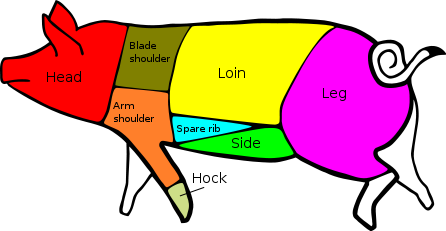As a continuation for the ultimate meat cheat sheet for beef, I figured next we would visit the type of meat that is most consumed throughout the world— pork! There are plenty of recipes already available on this site, but I thought it would be helpful for beginners if we had some research materials readily available.
Today we will focus on the different cuts of pork. This post will spotlight what part of the pig it is cut from and what kind of flavor it will have, but in the future we will discuss how each cut can be cooked!
Pricing key:
$ – under $5/lb
$$ – Between $6 – $10/lb
$$$ – More than $11/lb
Pork Butt $
Pork butt is also known as the Boston butt or pork shoulder. This can come bone in (typically 5-8 pounds) or boneless in smaller chunks. It’s a little fatty but extremely flavorful! As a side note, I was pretty curious why this was called a butt when it actually comes from the shoulder, and I found out that “butt” was rooted in old English and actually meant “the widest part”— you learn something new every day!
**Cut from the shoulder.
Pork Chops $ – $$
Most chops have a pretty high fat content, which leads to a full flavor even though the meat tends to be tougher. Pork chops can come bone in or boneless, but chances are if you’re getting a boneless chop its a rib piece.
**Cut from shoulder, rib, or loin.
Pork Loin $
This cut is typically large and tender, not containing a whole lot of fat. This can come boneless or bone-in. Pork loin is usually a little bit harder to carve because it comes from an area with a lot of muscle, and is often cut into chops or roasts.
**Cut from the back.
Spareribs $
Spareribs typically weigh about 5 pounds, as the cut contains the rib bones as well as the brisket bone. There is some fat in the cut, and the combination of that with the bone usually creates a very tender taste. St. Louis style ribs are from the same area of the pig, but cut down to be more manageable and fit better on a grill.
**Cut from belly area.
Baby Back Ribs $$
Baby back ribs are quite a bit smaller than spareribs, and racks weigh about 2 pounds. These ribs are much more lean than spareribs and can dry out easily. If you cook them properly, though, you’ll have more meat to enjoy than with spareribs and an amazing taste!
**Cut from back of pig, along vertebrae.
Pork Belly $$
Pork belly is very fatty (which isn’t surprising at all if you think about it) and therefore very flavorful! The belly is widely used in restaurants, and also makes everyone’s favorite food to obsess over— bacon!
**Cut from the belly.
Ham Hocks $
Ham hocks have a lot of fat, bone, and tissue with smaller amounts of meat. With that being said, it’s typically used to add flavor to dishes, like stews or veggies, rather than eaten.
**Cut from leg.
Ham $
Whole hams typically weigh about 20 pounds, and therefore are broken down into different sections, most often sirloin or shank end. The sirloin end will be a little more difficult to carve. Hams come covered in layers of fat and skin, and should be purchased with the bone in to get the ultimate flavor!
**Cut from rear legs.
Keep in mind that while the cut of pork can be a good initial indicator to the quality of meat you are getting, there are a lot of other factors to consider as well. Pork is not graded in the same sense that beef is, but good indicators of quality include color, marbling, and texture. You can find more information on determining pork quality here.







Leave a Reply